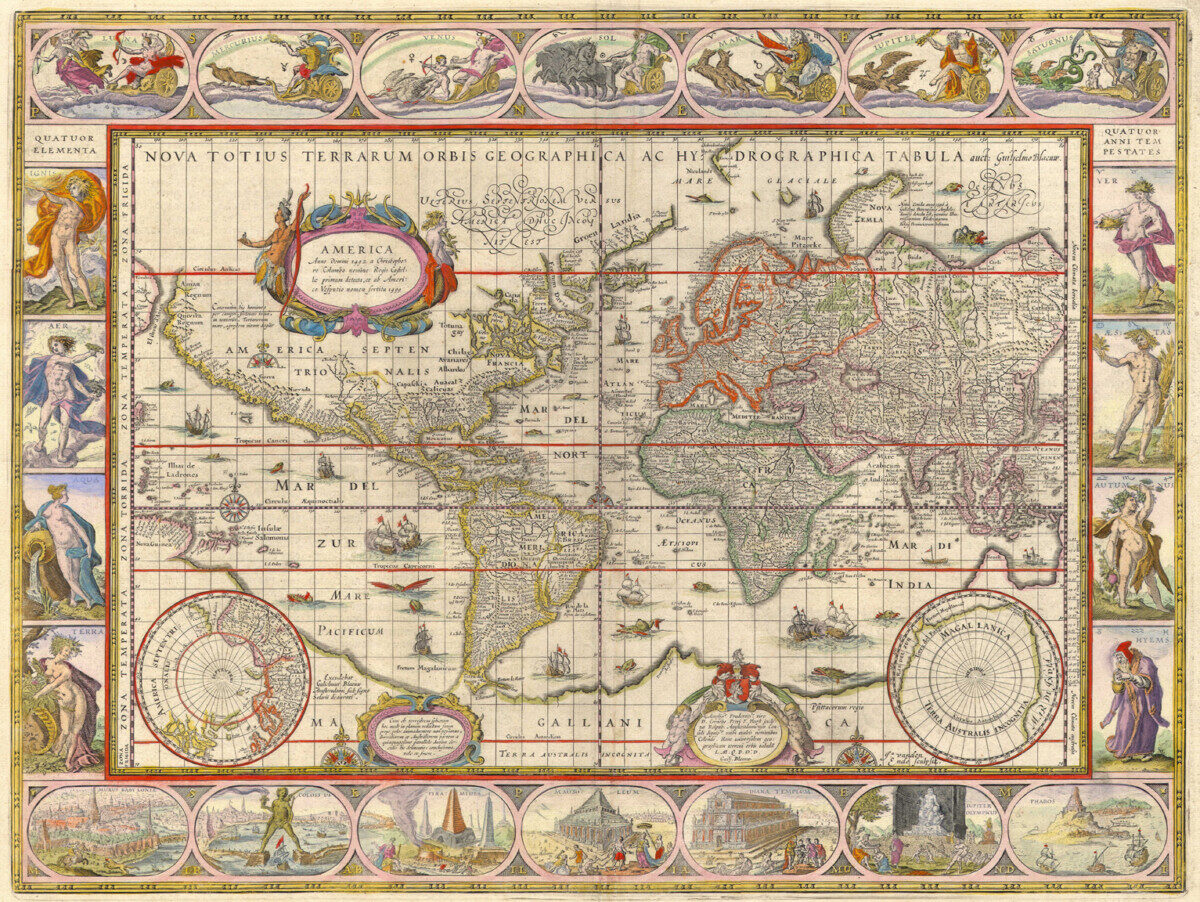Hannah Im | Final Thematic Essay | ARTHIST 259
Introduction
The nine muses of Greek mythology appear in Baroque art, but not in the way one might expect. The muses are physically visualized in many Baroque paintings, including Joos de Momper’s Minerva’s Visit to the Muses (Fig 1), but also have a figurative presence within the Baroque. Examples include Baroque Antiquarianism, which personifies the muse of history, and Caravaggio’s dramatic themes, which personifies the muse of tragedy. Most notably, Euterpe, the muse of music, has a hand in much of the subject matter of Baroque paintings. Within Dutch Golden Age paintings specifically, around 12% contain references to music (Wieseman 2013). Because musical motifs appear frequently in this era, the intersection between music and art must be further explored.
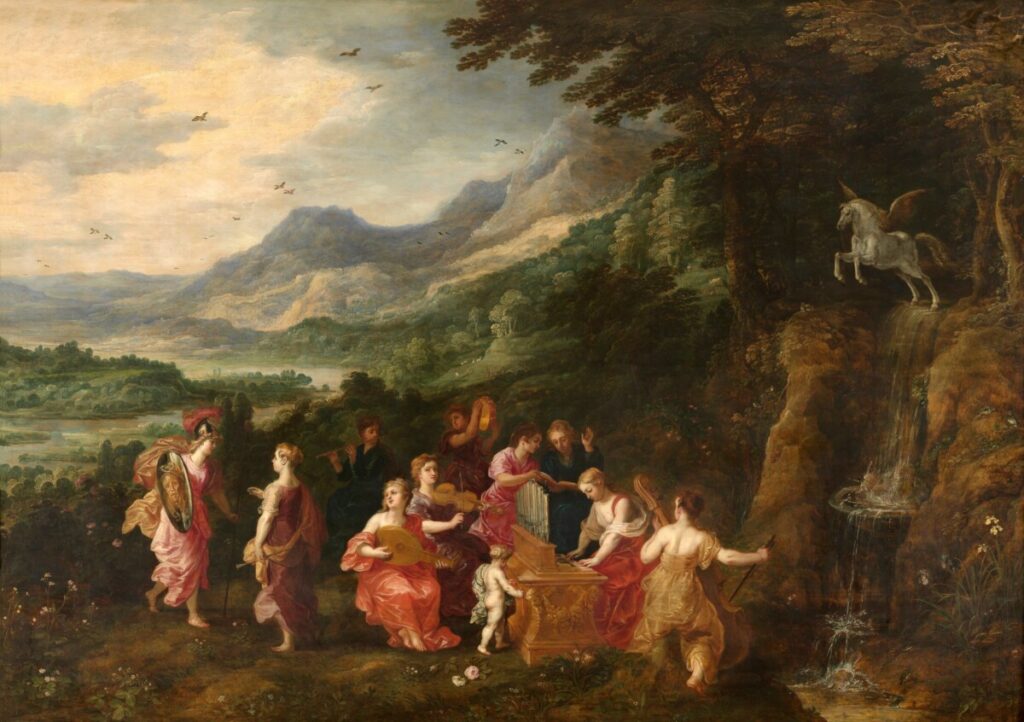
Various Baroque paintings containing images of music and instruments will be analyzed to understand the relationship between music and visual art during this time. Among these are works by renowned Dutch and Flemish artists, such as Vermeer, Peter Paul Rubens, and Judith Leyster. Additionally, musical themes used to communicate and subvert social forces will be explored. The intersection of Baroque art and music will also be examined through a global lens, as music was a vehicle of Dutch imperialism during this era; this intersection will be examined in China. The figurative role of the muses will be understood through examinations of paintings, global forces, and social interplays. The marriage of music and visual art in Netherlandish Baroque painting communicates the forbidden through rhetorical processes.
Historical Context
The Calvinist Church, city musicians, and taverns and brothels were among the actors that determined the musical landscape of the Low Countries. By the beginning of the Dutch Golden Era, most cities joined the Calvinist Church and forfeited “much of the rich musical culture of the Catholic Church,” which the Catholic Church offered through patronage and encouragement of artistic innovation (Wieseman 2013). Calvinists believed music to be a “violation of the Ten Commandments” and in line with “idolatry and worldly excess” (Wieseman 2013). Calvinists were restricted to unaccompanied congregational singing. Despite the lack of widespread religious musical development, everyday people breathed life into Dutch Baroque music. Dutch towns employed city musicians to perform at various events and funded musical organizations to study Italian or French musical styles in scholarly settings.
Opposite the Calvinist Church are danscamers and misekherbegen, or dance halls and music halls, respectively. Traveling musicians and patrons alike participated in music making. In fact, loud music and encouragement for customers to pick up instruments allowed for spontaneous music-making (Wieseman 2013). Music-making in private settings also supplemented music-making in the public sphere: many families learned multiple instruments, performed concerts during holidays, and signaled their status through music (Wieseman 2013). Dutch people subverted the Calvinist Church because of the ephemeral nature of music-making. Music’s large presence in Dutch society explains its large presence in Dutch paintings.
The Rhetorical Process and the Forbidden
Many artists and theorists of the Baroque era based their beliefs about rhetorical processes on Quintilian and Cicero, two Roman thinkers. Artists use rhetoric to construct a painting or musical composition to teach or arouse passion (Jensen 1976). According to these rhetoricians, artmaking consists of three primary steps: inventio, dispositio, and elocutio. Inventio consists of the discovery of a main idea and its subsequent images and ideas (Jensen 1976). The imagination can discover an idea by imitating other great works, drawing from nature, or representing the creator’s idea of perfection (Jensen 1976). Dispositio is the arrangement of the chosen images and ideas to best communicate the main idea (Jensen 1976). Musicians compose a primary theme and then create variations, while painters may place the primary figure in the most noticeable spot (Jensen 1976). Elocutio is the step most closely related to the art form and appeals to the senses through “colors, words, turns of phrase, and musical tones and figures” (Jensen 1976). Dutch artists followed these steps for various purposes, which will be examined later.
Many artists of the Dutch Golden Age used these steps in their own artmaking to communicate the forbidden, which includes a variety of taboos from this period. Baroque music, specifically opera, attempts to empower women and communicates sensual desires (McClary 2012). Additionally, the disguising of female actresses as men in opera “gestures toward the greater empowerment of women” by critiquing the woman’s status in the home (McClary 2012). Dutch Baroque art and music communicate themes of quotidian life and its transient nature, which counters common depictions at this time of religious institutions and royal families. Broadly, Dutch art represents sensual desires, attempts to define the role of women, and gives voice to the commonplace person through intentional, rhetorical decisions.
Rhetorical in Painting from the Low Countries
Dutch Baroque painting opposes religious and social forces by giving voice to both women and the everyday person. Dutch artists combine music and art to make rhetorical decisions to represent these subjects in novel ways. Judith Leyster and Peter Paul Rubens represent both the everyday and elite woman in their paintings using musical allusions. Jan Jansz and Carel Fabritius employ innovative visual devices to underscore the commonplace. Lastly, Vermeer’s genre paintings of women use both musical motifs to make sexual allusions and represent domesticity.
Women and Music in Dutch Painting
Leyster represented the everyday Dutch woman’s role in music-making through her placement of figures. Leyster’s The Concert (Fig 2) features three figures, which are initially unidentifiable. The two men on either side are holding a Baroque violin and lute and look to their respective sides. Leyster engages in dispositio by arranging the three figures in a certain way, with the female figure in the center. While the three figures look in different directions, the viewer’s eye is drawn towards the woman looking up. Further inspection also reveals the small songbook hidden between folds of clothing. During the Baroque era, the Dutch popularized songbooks, which were widely accessible to the common person due to their low cost (Wieseman 2013). Despite the lack of musical innovation in religious settings, women contributed to the flourishing of music by making it in their homes.

On the other hand, Ruben’s series of paintings features a prominent royal figure, Marie de’ Medici. She came to power in a kingdom that “excluded women from accession to the throne” (Galletti 2014). The series of paintings depict the queen’s life through a series of religious and mythological allegories; The Education of Marie de’ Medici (Fig 3) represents the Three Graces and other Greek gods endowing her with gifts, skills, and beauty. Galletti argues Rubens “fine-tuned” the allegorical language of this series to promote the queen’s “contentious political views” (2014). The two musical instruments in the foreground are among the objects physically representing the queen’s education. Rubens invents the idea that Queen Marie is an educated figure to oppose claims of her being a “fat banker” (Galletti 2014). The musical instruments act as attending images to support this idea.
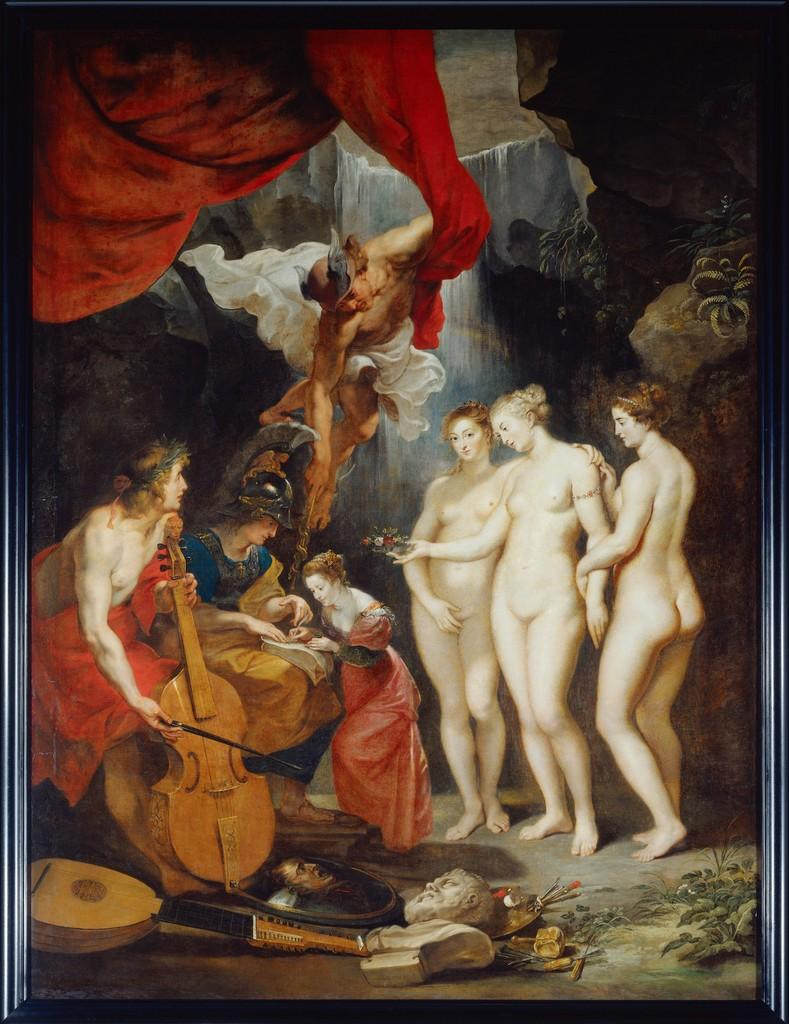
Temporality in Dutch Painting
Various Dutch artists use music and the forbidden concept of temporality to represent the everyday person. Jan Jansz. Treck was a Dutch still-life painter, who painted a vanitas, which is a specific still-life with symbolic objects. Among the Vanitas Still Life’s (Fig 4) most notable objects is a stack of sheet music, a shell filled with liquid, and a small straw. The shell and straw were used to blow bubbles, which was a common symbol for “the brevity of life” during this period (The National Gallery). Compared to other arts, like painting and architecture, music is also ephemeral in nature. Music makes a lasting impact on its listeners, but it is subjective based on the musician and the melodies cannot be directly taken outside of the performance space. Treck’s inclusion of the sheet music in the foreground and violin in the background adds to the theme of brevity.

Carel Fabritius also gives life to the everyday person in his painting A View of Delft (Fig 5). The perspective is unique, with a foreshortened instrument in the foreground and a fisheye view of the street. The foreshortened fingerboard leads the viewer’s eyes to the lute and man in the background. The man leans his elbow on the table and chin on his hand while sitting in the shadows. Wieseman argues the figure is “perhaps contemplating the transience of life,” where the instruments act as a “potent reminder” (2013). During the Baroque era, the “transitory nature of life” was often represented by “lute strings facing down” or away from the viewer (Coelho 2006). Through dispositio, Fabritius connects the everyday person with music by emphasizing the instruments with the trompe l’oeil effect. Musical motifs in both Fabritius’ and Treck’s paintings counter various religious and royal institutions; the transience of life overrides the power of these institutions. Commonplace people and royals alike must pass on.
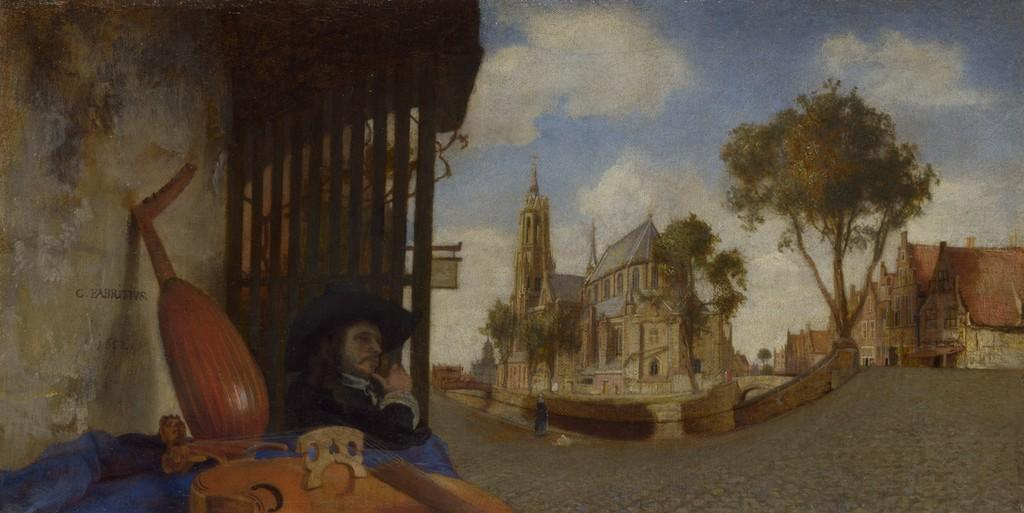
Women, the Quotidian, and Vermeer
Vermeer’s domestic scenes of middle-class life, portraits in the tronie style, and mysterious life are sources of intrigue for many. Interestingly, 12 of Vermeer’s 36 genre paintings and portraits contain musical motifs (Wieseman 2013). One such painting is The Music Lesson (Fig 6), which features a woman playing a muselar virginal and a man standing to the side. A viola da gamba rests on the floor behind the table; stringed instruments resemble the curves of a woman’s body (Wieseman 2013). The man’s parted lips convert this live, audible performance into a static image, as is done in many other Dutch genre paintings (Wieseman 2013). Overall, the motif of men teaching women music provides opportunities to make “subtly provocative images” (Wieseman 2013). Such provocative themes are forbidden, and the representation of them undermines the Calvinist Church’s prohibition of graven images.
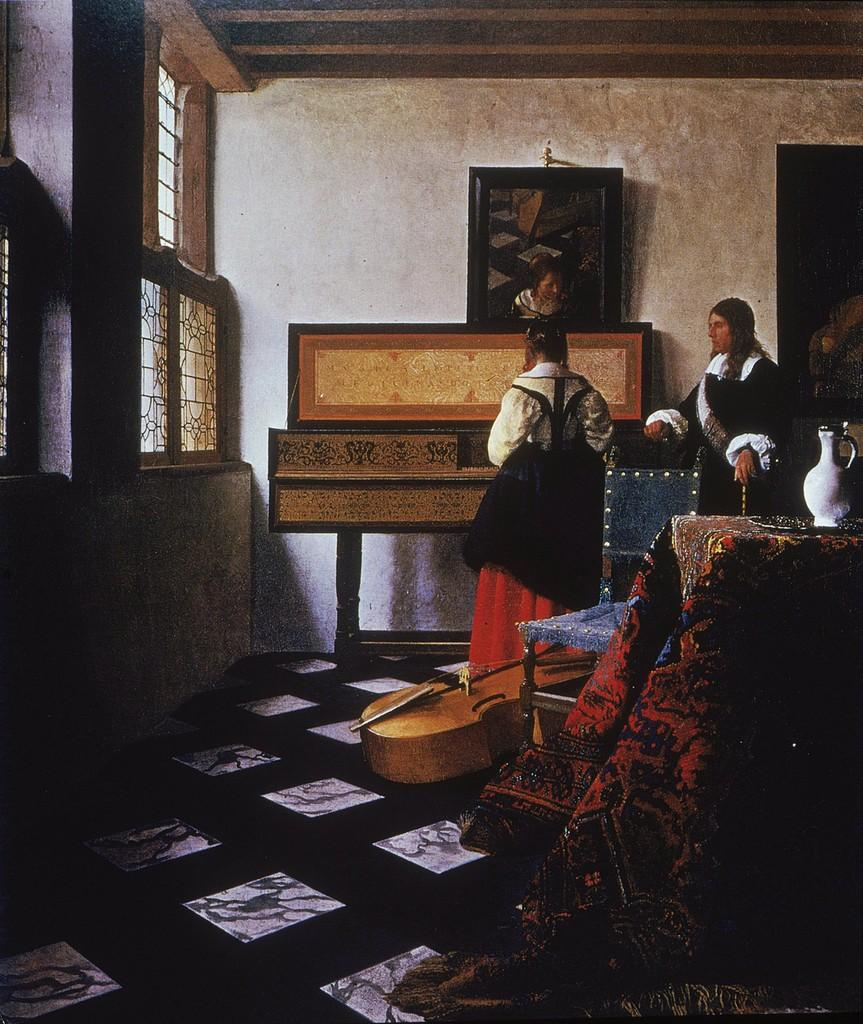
Another of Vermeer’s paintings of music include Young Woman at a Virginal (Fig 7), which highlights a female musician. The object features a woman seated at a virginal. Her shawl and skirt have folds with contrasted highlights and shadows. The wall and virginal have less contrast and feel two-dimensional in comparison. This difference in contrast enhances the painting’s intimate feel and woman’s intense gaze. Vermeer’s paintings subvert the social forces of Calvinism and the patriarchy by giving women a voice through music.

The Muses in Baroque China
During the Baroque period, cultural exchange occurred due to extensive trade routes, imperialism, and increasing globalization. It is important to acknowledge not all people groups were open to cultural exchange or capable of resisting it. Cultural exchange was not always a mutually beneficial occurrence and sometimes functioned more like a parasitic relationship. In fact, the Dutch were among the many European players who forced themselves onto certain groups, whether through slavery or colonization. The Ming and Qing Dynasties, however, were receptive to foreign ideas. The Ming Dynasty was not particularly nationalistic, and the Qing Dynasty found ways to incorporate foreign ideas into their own needs (Lindorff 2014).
The Portuguese and Dutch were some of the Western countries to introduce the Baroque keyboard to China. In 1656, two Dutch musicians gifted the Qing Dynasty with a harpsichord. The clavichord originally came with the Italian Jesuits to promote Christianity in the Confucianist and Buddhist nation. Like in The Education of Marie de’ Medici (Fig 3), the clavichord and harpsichord in China signaled culture, well-roundedness, and education (Lindorff 2014). There is a lack of research on how the introduction of the Western Baroque keyboard allowed for Qing Dynasty artists to communicate the forbidden. The forbidden in China, the intersection of music and art during the Qing Dynasty, and the impact of interaction with the Dutch will be interesting to explore further.
Conclusion
The depiction of music in Dutch Baroque painting creates a visual culture that subverts the various social, political, and religious powers of the time. During the Dutch Golden Age, the Calvinist Church placed restrictions on music-making in religious settings. Additional societal forces include patriarchal views of women. The subject matter Calvinists and societal institutions suppressed are communicated by many Dutch artists using musical motifs. Judith Leyster, Peter Paul Rubens, Jan Jansz. Treck, Carel Fabritius, and Vermeer followed specific rhetorical steps to marry music and painting. These artists uncovered the forbidden through rhetorical steps, intentional visual devices, and interesting compositions. The visual culture of the Low Countries is created through music’s ephemeral nature and painting’s ability to memorialize. The muses worked in tandem to uncover the forbidden in the Dutch Baroque era and likely still do today.
Digital Tool
Want to know what these paintings sounded like? View this ARCGIS Story Map for a multimedia perspective.
References
Coelho, Victor. “The Baroque Guitar.” Essay. In The World of Baroque Music: New Perspectives, edited by George B. Stauffer, 169–84. Bloomington, IN: Indiana University Press, 2007.
Fabritius, Carel, A View of Delft, with a Musical Instrument Seller’s Stall, Oil on canvas, 1650, (The National Gallery, London; Presented by The Art Fund), https://jstor.org/stable/community.15663666.
Galletti, Sara. “Rubens’s Life of Maria de’ Medici: Dissimulation and the Politics of Art in Early Seventeenth-Century France.” Renaissance Quarterly 67, no. 3 (2014): 878–916. https://doi.org/10.1086/678777.
Jensen, H. James. The Muses’ Concord: Literature, Music, and the Visual Arts in the Baroque Age. Bloomington, IN: Indiana University Press, 1976.
Leyster, Judith, The Concert, Oil on canvas, ca. 1633, (National Museum of Women in the Arts, Gift of Wallace and Wilhelmina Holladay), https://commons.wikimedia.org/wiki/File:Judith_Leyster_The_Concert.jpg.
Lindorff, Joyce. “Missionaries, Keyboards and Musical Exchange in the Ming and Qing Courts.” Early Music 32, no. 3 (2004): 403–14. http://www.jstor.org/stable/3519339.
McClary, Susan. Desire and Pleasure in Seventeenth-Century Music. Berkeley, CA: University of California Press, 2012.
National Museum of Women in the Arts. “The Concert.” NMWA, August 9, 2021. https://nmwa.org/art/collection/concert/.
Rubens, Peter Paul, Education of Marie de’ Medici (Apollo and Mercury Lead Her in Music and Eloquence While Minerva Teachers Her to Read and the Three Graces Offer Beauty), Canvas, 1621-25, (Musée du Louvre), https://jstor.org/stable/community.14498853.
The National Gallery. Vanitas Still Life. Accessed April 24, 2023. https://www.nationalgallery.org.uk/paintings/jan-jansz-treck-vanitas-still-life.
Treck, Jan Jansz, Vanitas Still Life, Oil on oak, 1648, (The National Gallery, London; Presented by Anthony N. Sturt and his wife Marjorie), https://jstor.org/stable/community.15659917.
Van Balen the Elder, Hendrick, Joos de Momper, Jan Breughel the Elder, Minerva Visits the Muses, Oil, early 17th century, (Antwerp), Wikimedia Commons.
Vermeer, Johannes, The Music Lesson, Oil on canvas, 1662-65, (Buckingham Palace (London, England)), https://jstor.org/stable/community.13592426.
Vermeer, Johannes, Young Woman Seated at the Virginals, Oil on canvas, 1670-72, (Wynn Las Vegas), Wikimedia Commons.
Wieseman, Marjorie Elizabeth. Vermeer and Music: The Art of Love and Leisure. London: National Gallery, 2013.
